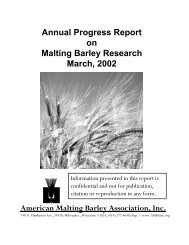Annual Progress Report on Malting Barley Research March, 2007
Annual Progress Report on Malting Barley Research March, 2007
Annual Progress Report on Malting Barley Research March, 2007
You also want an ePaper? Increase the reach of your titles
YUMPU automatically turns print PDFs into web optimized ePapers that Google loves.
• Our c<strong>on</strong>tinued collaborati<strong>on</strong> <strong>on</strong> leaf and head disease screening c<strong>on</strong>tributed to the<br />
development of a good disease resistance package in line ND20448, a line with less FHB<br />
than Robust and good malting characteristics. ND20448 was found acceptable in its first<br />
year of AMBA Pilot Scale Evaluati<strong>on</strong>.<br />
• Our c<strong>on</strong>tinued collaborati<strong>on</strong> <strong>on</strong> leaf and head disease screening c<strong>on</strong>tributed to the<br />
development of a good disease resistance package in Stellar-ND, which has been found<br />
satisfactory in <strong>on</strong>e year of Anheuser-Busch plant scale testing and two years of Miller<br />
Brewing plant scale testing.<br />
DETAILED REPORT<br />
1. Evaluate elite barley germplasm and segregating breeding populati<strong>on</strong>s for<br />
resistance to Fusarium Head blight (FHB) and the accumulati<strong>on</strong> of deoxynivalenol.<br />
Working together with the breeders, Prof R. Horsley and Prof. J. Franckowiak, NDSU (until<br />
retirement in July 06), the barley pathology project has led the establishment, inoculum<br />
producti<strong>on</strong>, inoculati<strong>on</strong>, maintenance and screening for FHB resistance in irrigated and<br />
dryland plots of barley in North Dakota. In 2006, a total of 162 NABSEN rows were<br />
screened for Fusarium Head Blight in multiple field locati<strong>on</strong>s including irrigated experiments<br />
at Fargo, China and Langd<strong>on</strong>.<br />
The barley pathology group also screened under both irrigated and n<strong>on</strong>-irrigated<br />
envir<strong>on</strong>mental c<strong>on</strong>diti<strong>on</strong>s about 300 rows of unique lines being tested for Fusarium<br />
resistance from the combined program of Dr Lynn Dahleen at Cereal Crops <strong>Research</strong> Unit<br />
USDA Fargo and Dr Phil Bregitzer at Small Grains <strong>Research</strong> Unit USDA, Aberdeen Idaho.<br />
The North American Barely Scab Evaluati<strong>on</strong> Nursery (NABSEN) trials were co-ordinated<br />
and ND trials were established at Langd<strong>on</strong> ND, Fargo ND and Hangzhou China with part<br />
funding from the US Wheat and <strong>Barley</strong> Scab Initiative. The 48 experimental entries and the<br />
6 resistant or susceptible c<strong>on</strong>trols include lines from NDSU 6-rowed breeding program,<br />
NDSU 2-rowed breeding program, Minnesota breeding program, Busch-Ag breeding<br />
program, CIMMYT breeding program and the Agriculture & Agri-Food Canada <strong>Research</strong><br />
breeding program as well as the USDA Cereal Crops <strong>Research</strong> Unit <strong>Barley</strong> Genetics<br />
program. This collaborati<strong>on</strong> facilitates exchange of germplasm between the participating<br />
breeding programs and allows comparis<strong>on</strong>s of performance across a range of<br />
envir<strong>on</strong>ments.<br />
Approximately 1,000 rows of lines from the diverse germplasm screening projects at NDSU<br />
<strong>Barley</strong> Pathology, Minnesota <strong>Barley</strong> Pathology, Agriculture Canada Brand<strong>on</strong> and<br />
ICARDA/CIMMYT <strong>Barley</strong> Breeding Program were evaluated in off-seas<strong>on</strong> trials at Zheijiang<br />
University in Hangzhou China. A total of 157 rows of the same material were evaluated in<br />
Fargo ND and Langd<strong>on</strong> ND. Assessments were made when entries were at the soft dough<br />
stage of development. Characters recorded included, infected kernels per head, number of<br />
infected heads and total kernels per head.<br />
2. Screen barley cultivars for resistance to spot blotch.<br />
Field: A total of 189 plots of advanced 2-rowed or 6-rowed breeder’s lines were screened<br />
for spot blotch (Cochliobolus sativus) resistance in the field at Fargo in irrigated and<br />
62
















